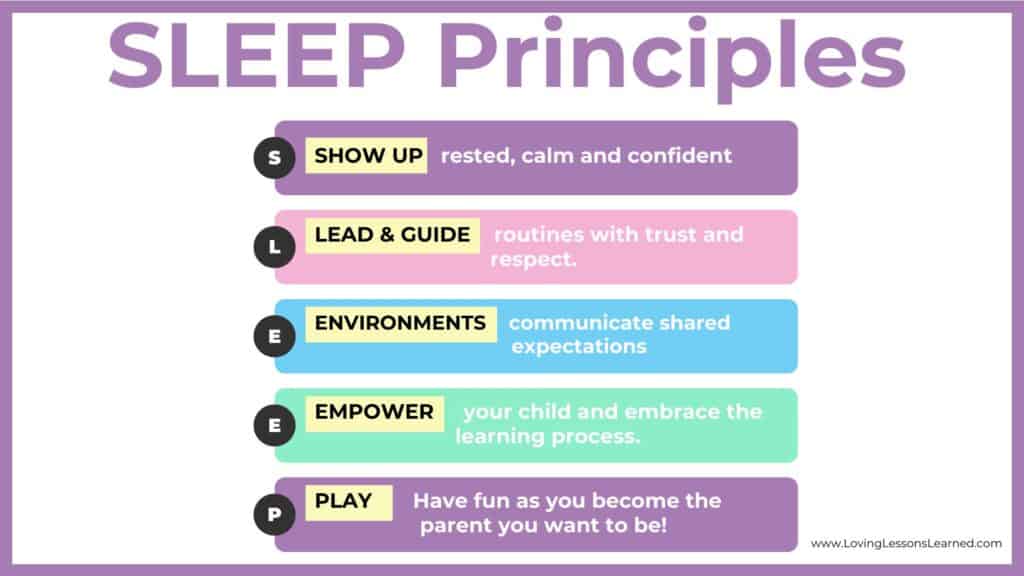Stop Bedtime Battles: How to Create a Flexible Sleep Routine for Your Child

By Irene Gouge
Why Won’t My Toddler Sleep at Night? Understanding Bedtime Battles
Are you dealing with bedtime battles, night wakings, or toddler sleep resistance? If your child refuses to sleep, delays bedtime with “just one more” requests, or wakes up frequently, you’re not alone.
Many parents search for:
- “How to stop bedtime battles with toddlers”
- “Best bedtime routine for kids”
- “How to help my child sleep through the night”
The good news? You can transform bedtime into a peaceful, predictable process. This guide will show you how to create a sleep-friendly routine using the SLEEP principles—helping both you and your child get the rest you need.

*Infographic displaying the five Sleep Principles—Show Up, Lead, Environment, Empower, and Play—each represented by a guiding principle.
S – Show Up as a Calm, Confident, and Rested Parent
Your energy sets the tone for bedtime. If you’re anxious, frustrated, or planning on your time after your little one goes to sleep, your child will pick up on it – and that makes it harder to rest. Before tackling your child’s sleep, focus on your own well-being:
How to Stay Calm & Confident at Bedtime
✔ Take care of yourself daily – Deep breaths, hydration, and small moments of self-care make a big difference.
✔ Understand what’s developmentally normal – If your toddler resists bedtime, it’s not defiance—it’s a developmental stage. Letting go of the day is hard and your child is looking for you to show up as their kind and firm leader, so reframe your thinking.
✔ Build in moments of rest – If you have a newborn or a child waking at night, recharge during the day when possible. Take 5-20 minutes to lay down horizontally.
Taking care of you helps you show up and be present with your little one as they drift off to sleep.
Need help staying calm at bedtime?
Download the FREE Breathe LOVE Guide, where you’ll learn how to Listen, Observe, Validate, and Empower yourself and your child—leading to less stress and fewer bedtime struggles.
L – Lead and Guide the Routines with Trust and Respect
Children feel secure when they know what to expect. Without a consistent routine, they’re more likely to resist bedtime or wake up at night.
Realistic & Best Bedtime Routine for Kids (Step-by-Step Guide)
1️⃣ Set a Consistent Wake Time
A predictable wake time helps regulate your child’s circadian rhythm (internal body clock), making it easier for them to fall asleep at night and wake up feeling rested. Most children naturally wake between 6:00 AM and 7:30 AM—sticking to a regular wake time supports their overall sleep quality.
2️⃣ Set a Consistent Bedtime
For toddlers and preschoolers, the best bedtime is between 7:00 PM and 8:00 PM. A predictable bedtime ensures they get enough quality restorative sleep to support their growth, mood, and cognitive development.
3️⃣ Use a Simple Bedtime Routine
A structured bedtime routine provides physical and sensory cues that signal to your child’s body that it’s time to wind down. The best bedtime routine for kids is simple and soothing:
Bath → Pajamas → Snuggles → Book → Song → Sleep
Each step reinforces a sense of security and predictability, making the transition to sleep smoother.
4️⃣ Offer Choices to Reduce Power Struggles
As your child grows, bedtime should be something you do WITH them, not TO them. Offering simple choices empowers your child while maintaining structure.
Try: “Do you want to wear the blue pajamas or the green ones?”
This age-appropriate independence helps them feel in control while keeping bedtime cooperative and positive and you leading your child through the routine.
5️⃣ Stay Consistent (Even on Weekends!)
The body thrives on consistency. Keeping bedtime within 15-30 minutes of the usual time (even on weekends) helps regulate your child’s internal clock, making it easier for them to fall asleep and wake up feeling refreshed.
Sleep Coach Tip: If your child struggles with transitions, use a visual bedtime checklist or chart so your toddler or preschooler knows exactly what to expect each night and empower them to take part of the process!.
"A good night of sleep begins first thing in the morning with a good morning routine!"
Irene Gouge
E – Establish Environments and Communication That Support Sleep
Your child’s sleep environment plays a crucial role in how well they fall asleep and stay asleep throughout the night. A thoughtfully created sleep space can reduce wake-ups, improve sleep quality, and foster independent sleep skills.
Sleep Environment Checklist:
✔ Keep the room dark – Blackout curtains help prevent early wake-ups by blocking out morning light.
✔ Use white noise – A sound machine can help mask household noises, creating a consistent and soothing sleep atmosphere.
✔ Keep it cool (65-70°F) – A cooler room temperature supports deeper, more restorative sleep.
✔ Remove screens 1 hour before bed – Blue light exposure disrupts melatonin production, making it harder for your child to fall asleep.
✔ Encourage independent sleep at bedtime – Provide your child with the opportunity to fall asleep on their own at the beginning of the night. Creating space for independence means gradually stepping back so your presence isn’t required for them to drift off.
Does Your Child Wake Up Frequently?
A consistent, decluttered, and familiar sleep space helps children connect sleep cycles more easily. What you do at bedtime is what your child will need at night. The more comfortable they feel in their own sleep environment, the better they can settle and return to sleep independently when they naturally wake between sleep cycles.
By setting up a calm, predictable, and independent sleep space, you create the foundation for longer, more restful nights for both you and your child.
E – Empower Your Child and Embrace the Learning Process
Just like any other skill, falling asleep independently takes time to develop. Instead of expecting perfection, focus on progress, consistency, and connection to build your child’s confidence in sleep.
How to Support Your Child in Falling Asleep on Their Own
✔ Be present, then gradually fade out your support – Start by offering comfort as needed, then slowly reduce your presence over time. This allows your child to develop self-soothing skills while still feeling secure.
✔ Give them space to settle – Avoid rushing in at the first fuss. Instead, take a moment to Breathe LOVE—Pause, Listen, Observe, Validate, and Empower—to help yourself respond rather than react.
✔ Create a connected bedtime routine – Notice how you end the day together. Find ways to play, laugh, and connect during the transitions after school and work that lead up to the bedtime routine, which helps reduce stalling and bedtime resistance.
✔ Acknowledge bedtime fears – Separation at night can be difficult for some children. A special stuffed animal, nightlight, or reassuring bedtime phrase can help them feel safe.
✔ Practice “YES” spaces throughout the day – Bedtime is often a child’s only time alone, which can make it feel like a major separation. Instead, encourage independent play and quiet moments in safe “YES” spaces during the day so bedtime feels like a natural transition, not an abrupt change.
Sleep Coach Tip for Connection: Children crave our proximity—not just at bedtime, but throughout the day. When we prioritize attachment and connection from the morning onward, it helps our little ones feel secure enough to sleep peacefully at night. How we communicate, engage, and nurture connection throughout the day directly impacts how bedtime unfolds.
By building trust, predictability, and emotional security, you set the foundation for better sleep and smoother nights for everyone.
P – Play, Have Fun, and Become the Parent You Want to Be While Everyone Gets Sleep
Sleep doesn’t have to feel like a chore! A playful, lighthearted approach can ease bedtime resistance.
Fun Ways to Make Bedtime Easier
✔ Turn bedtime into a game – Race to brush teeth, use silly voices in a bedtime story.
✔ Create special bedtime rituals – A secret handshake, a lullaby, special song or a “goodnight whisper” make bedtime feel safe and connected.
✔ Celebrate small wins – If bedtime was 5 minutes smoother tonight, that’s progress!
The more positive bedtime feels, the easier sleep becomes for your child.

Let’s recap: How to Stop Bedtime Battles and Help Your Child Sleep Better
To transform bedtime battles into peaceful sleep routines, remember to:
✅ Stay calm and confident – Your energy matters.
✅ Lead bedtime routines with trust – Predictability reduces resistance.
✅ Create a sleep-friendly environment – Darkness, white noise, and a cool room help sleep.
✅ Empower your child’s sleep skills – Give them space to settle and set clear expectations.
✅ Have fun! – A positive bedtime sets the tone for restful nights.
Your Next Step: Download the FREE Breathe LOVE Guide!
Want to stop bedtime battles and create a stress-free bedtime routine?
The Breathe LOVE Guide will teach you how to:
✔ Listen, Observe, Validate, and Empower both yourself and your child.
✔ Shift from reacting to responding at bedtime.
✔ Feel calm, confident, and rested while supporting your child’s sleep.
Download your FREE Guide start creating the bedtime experience your family deserves!
About the author.
Irene Gouge with Loving Lessons Sleep Solutions works as a Sleep Coach and Postpartum doula in the Raleigh/ Durham area where she’s known for helping parents get MORE sleep with the right strategies.
She works with anxious, overwhelmed parents in and out of the home that have a newborn to preschool aged child. She provides Sleep Success Coaching that offers a holistic approach to sleep challenges where she helps pinpoint issues to get to the root cause of sleep disruptions, creates a plan of action to help you know where to focus and shares proven tools and strategies that enhance trust and foster respectful communication with your child. Parents become rested calm, and confident in their parenting journey.
Have sleep questions or concerns, connect with Irene here on her calendar.
Connect with Irene:
Spread the word
Medical Disclaimer: All content found on the HER Health Collective Website was created for informational purposes only and are the opinions of the HER Health Collective experts and professional contributors. The Content is not intended to be a substitute for professional medical advice, diagnosis, or treatment. Always seek the advice of your physician or other qualified health providers with any questions you may have regarding a medical condition. Never disregard professional medical advice or delay in seeking it because of something you have read on this Website. If you think you may have a medical emergency, call your doctor, go to the emergency department, or call 911 immediately.
